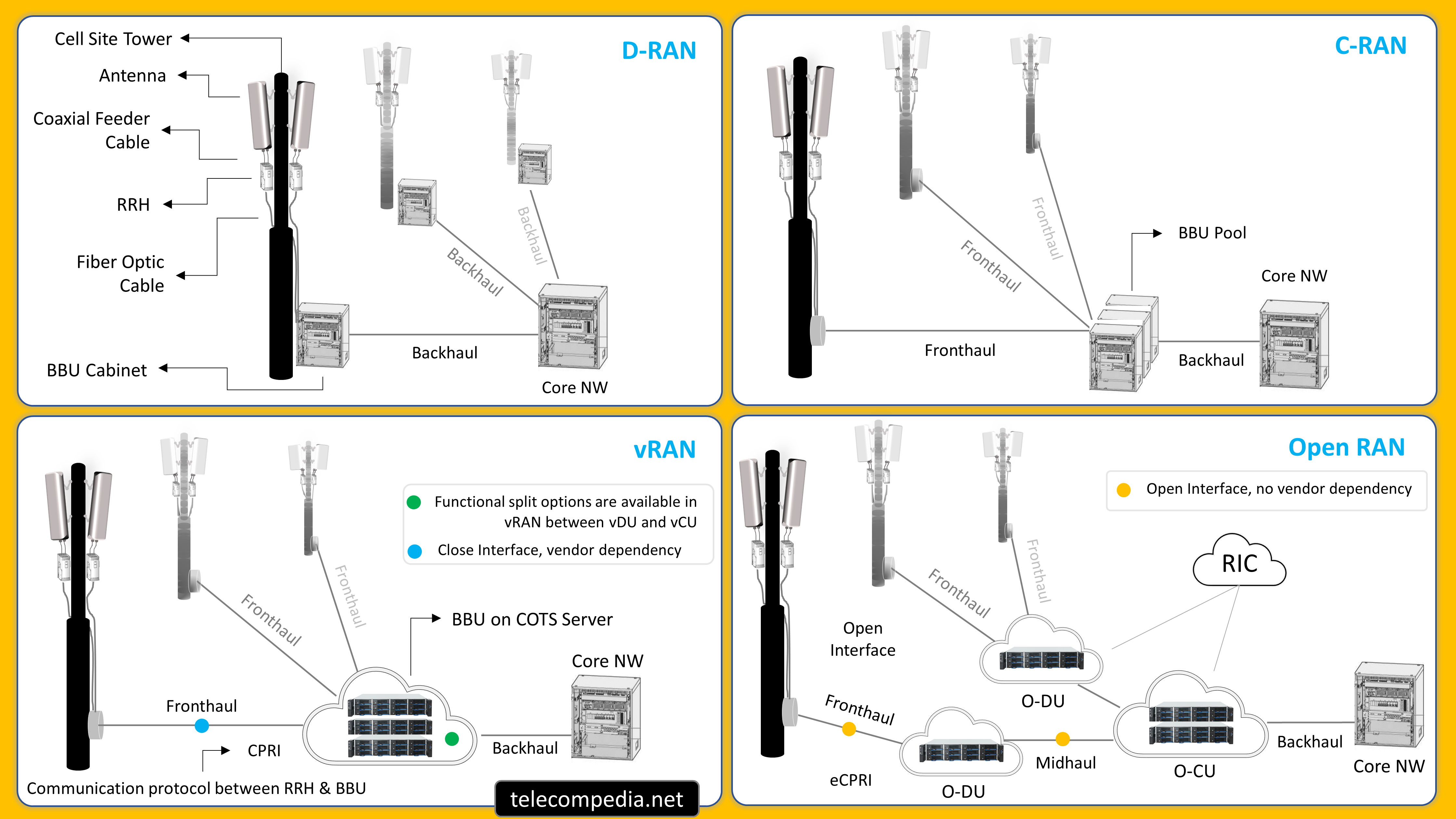RAN domain is an expensive part of any cellular network, even it can cost more than 60% from total budget of CAPEX and OPEX for any MNO. And also since beginning this domain had a lots of dependency by the vendors. If an MNO builds a cellular network, then hardware and software must from the same vendor. And a lots of other constraints, dependencies and costs urge the vendors and operators to enhance the RAN domain with new approaches. Let’s review them one by one:
D-RAN stands for Distributed-RAN, it is one of the early versions of radio access network where Remote Radio Head (RRH, also known as RRU) and Base-band Unit (BBU) are co-located in the physical location for each cell site. So, the RAN is distributed all over the geographical area.
Of course, it was beneficial until new options arrived at the stage, which we will talk one by one according to the phases below.
Disadvantages:
- Vendor lock-in for both hardware RRH/BBU and software must be from the same vendor
- Insufficient resource sharing. In case of low traffic areas, RAN capacity will not be sufficiently utilized.
- High operatorial costs. Each site should be visited by field maintenance engineers which directly impacts OPEX.
C-RAN stands for Centralized-RAN and also known as Cloud-RAN. It is an enhanced version of D-RAN. Why? The reason, now the BBU will not be co-located with RRH in the cell site place. BBU of multiple cell sites will be in the same physical premises and the resources can be shared dynamically (called as BBU Pool or BBU Hotel). That is a great achieved approach with many advantages.
Interface name between BBU and RRH is called as fronthaul
Advantages:
- Computing resource sharing constitutes such as CPU, RAM etc.
- Reduced operational costs, where multiple sites can be maintained from the same physical location. Saving from rental fees (larger place is required in case of RRH/BBU co-location).
- Improved inter-cell coordination (e.g., eICIC works more efficiently due to low latency communication between different sites).
Disadvantages:
- Still keeps vendor dependency like D-RAN
- High data burden on fronthaul due to large amount of data from RRH to BBU for processing. But further to overcome this issue 3GPP proposed functional splits between three entities like Radio Unit, Distributed Unit (DU) and Central Unit (CU). In this case some major processing can be done in DU (e.g., RLC, MAC, PHY) and in CU (e.g., RRC, PDCP and SDAP in 5G scenario).
vRAN stands for Virtualized-RAN. It is almost same like C-RAN but now there is no hardware dependency on some major entities of the RAN architecture. BBU as a software package is on top of COTS servers. What does it mean ?
It means, BBU (it can also be functional split like vDU and vCU) is only a software package provided by a vendor. It will be located on the COTS server as a VNF or CNF.
COTS servers are commercially available off-the-shelf, so it can be easily purchased from a COTS server producer and put the BBU software top of it.
But even though it could be achieved software-hardware decoupling at BBU level, still it has disadvantages like:
- Not open interfaces, still vendor proprietary exits. RRH and BBU (vDU and vCU) must be from the same vendor.
Open RAN, this is latest enhanced version of RAN solution. It keeps all benefits of C-RAN and vRAN solutions but now opens interfaces between RRH, vDU and vCU plus adds intelligent to the radio access network. In this case there will be no vendor lock-in, and the MNO can compose the RAN network with different vendors.
For having complete understanding of Open RAN solution, you can check these articles:
Open RAN with Bullets – Part 1
Open RAN with Bullets – Part 2
Let’s recap here about different approaches of Radio Access Networks:
D-RAN: Radio Unit and Baseband Unit co-locate in each cell site. Software and hardware must be from the same vendor.
C-RAN: Radio Unit locates in cell site, but Baseband Unit locates in centralized location. Software and hardware must be from the same vendor.
vRAN: Radio Unit locates in cell site and Baseband Unit locates in centralized location or can be functional split as DU, CU. The BBU is virtualized and locates on top of COTS server, but still BBU and RRU must be from the same vendor.
Open RAN: as the name gives hint, the interfaces will be open between Radio Unit, DU, and CU. There is no vendor dependency, each entity can be supplied from different vendor. You may also see O-RAN and OpenRAN (without hyphen) in different documents. These are not another versions of RAN solution, to find an answer check Open RAN with Bullets – Part 1
- D-RAN is not C-RAN
- C-RAN is not vRAN
- vRAN is not Open RAN
but Open RAN has parts from all previous RAN solutions, and it is intelligent with RIC.
Reference:
- VIAVI – Cloud-RAN Deployment with CPRI Fronthaul Technology
- Potentials and Challenges of C-RAN Supporting – Rui Wang, Honglin Hu, Xiumei Yang
- Coordination inside centralized radio access networks with limited fronthaul capacity – Jialong Duan
